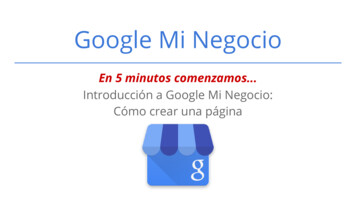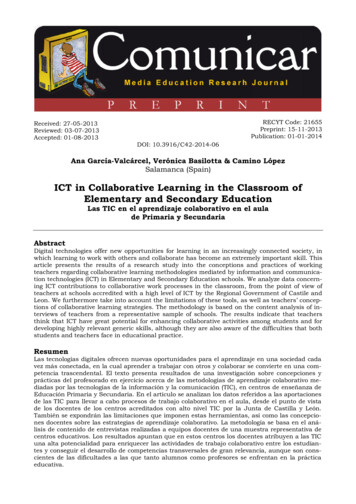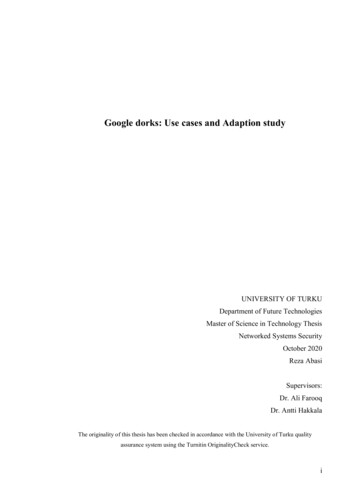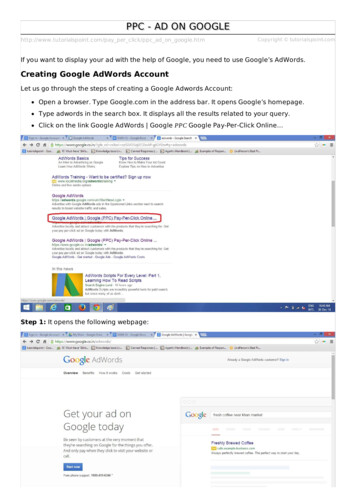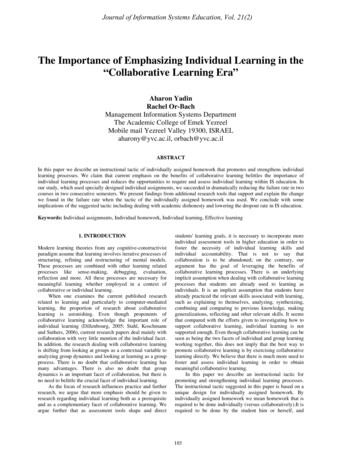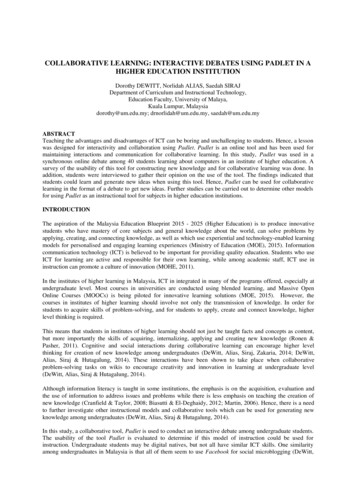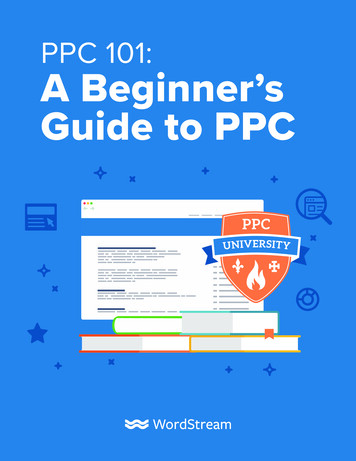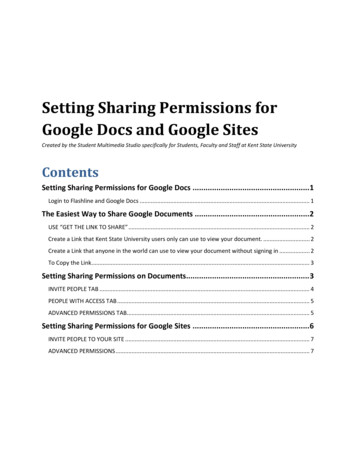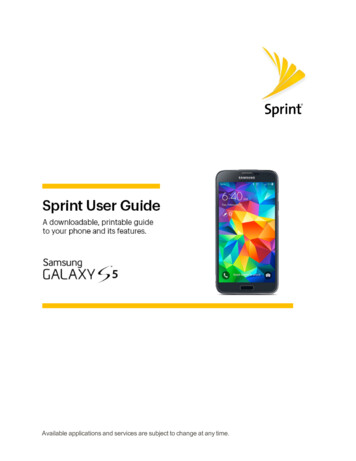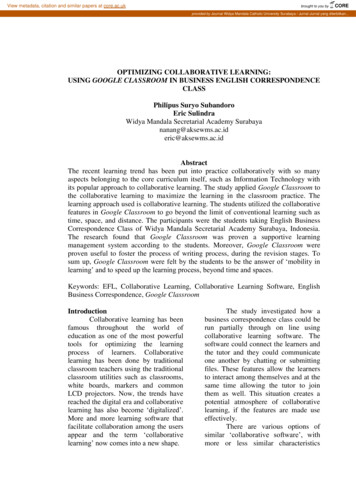
Transcription
View metadata, citation and similar papers at core.ac.ukbrought to you byCOREprovided by Journal Widya Mandala Catholic University Surabaya / Jurnal-Jurnal yang diterbitkan.OPTIMIZING COLLABORATIVE LEARNING:USING GOOGLE CLASSROOM IN BUSINESS ENGLISH CORRESPONDENCECLASSPhilipus Suryo SubandoroEric SulindraWidya Mandala Secretarial Academy ractThe recent learning trend has been put into practice collaboratively with so manyaspects belonging to the core curriculum itself, such as Information Technology withits popular approach to collaborative learning. The study applied Google Classroom tothe collaborative learning to maximize the learning in the classroom practice. Thelearning approach used is collaborative learning. The students utilized the collaborativefeatures in Google Classroom to go beyond the limit of conventional learning such astime, space, and distance. The participants were the students taking English BusinessCorrespondence Class of Widya Mandala Secretarial Academy Surabaya, Indonesia.The research found that Google Classroom was proven a supportive learningmanagement system according to the students. Moreover, Google Classroom wereproven useful to foster the process of writing process, during the revision stages. Tosum up, Google Classroom were felt by the students to be the answer of ‘mobility inlearning’ and to speed up the learning process, beyond time and spaces.Keywords: EFL, Collaborative Learning, Collaborative Learning Software, EnglishBusiness Correspondence, Google ClassroomIntroductionCollaborative learning has beenfamous throughout the world ofeducation as one of the most powerfultools for optimizing the learningprocess of learners. Collaborativelearning has been done by traditionalclassroom teachers using the traditionalclassroom utilities such as classrooms,white boards, markers and commonLCD projectors. Now, the trends havereached the digital era and collaborativelearning has also become ‘digitalized’.More and more learning software thatfacilitate collaboration among the usersappear and the term ‘collaborativelearning’ now comes into a new shape.The study investigated how abusiness correspondence class could berun partially through on line usingcollaborative learning software. Thesoftware could connect the learners andthe tutor and they could communicateone another by chatting or submittingfiles. These features allow the learnersto interact among themselves and at thesame time allowing the tutor to jointhem as well. This situation creates apotential atmosphere of collaborativelearning, if the features are made useeffectively.There are various options ofsimilar ‘collaborative software’, withmore or less similar characteristics
called ‘learning management system’, acomputer software that helps learner tomanage learning by providing helpfulfeatures. One of the famous ones isGoogle Classroom. Google Classroomhas many features that supportcollaborative learning in a classroom.Language classrooms are one of themthat have made use of the advantagesfrom Google Classroom features. Inmany language classes, with differenteffects according to the differentcharacteristics of the classrooms.There have been several studiesconcerning the use of GoogleClassroomorotherlearningmanagement systems (LMS). Insummary, these LMS are used forincreasing the students participation(Ezekoka, 2014), developing relevantgeneric skills (Valcarcel. et all, 2014),to improve students engagement inlearning and also their achievement(Maniunas, 2004), and to enhance theeffect of collaborative learning itself(Chai, C.S. and Tan, S.C., 2010).In terms of improving students’participation in the collaborativelearning, Ezekoka (2014) found that thelevelofstudents’participationincreased along the way with theirengagement in the project. Therespondents said that they participatedmore because of the reduction of timeand space limitation.Expanding more findings aboutstudents’participation,Valcarcel(2014) found that both students and theteachers felt satisfied with the learningprocess using ICT which impacteddirectly on students’ satisfaction inlearning. Thus, it also brought morepositive attitude towards learning.In Maniunas’ research (2004),learning using ICT opened a wide rangeof creativity such as using games andallowing interaction among its users.The study made use one of them andput it into an investigation. Theinvestigation tried to reveal theadvantages and disadvantages of usingthe software in terms of supporting theeffectiveness of collaborative learning.The study was trying to investigatethe factors and characteristics ofcollaborative learning and how thecollaborative learning software affectsthe learning of students in BusinessEnglish Correspondence Class.The study was implemented intwo fields which were inter-related oneanother, English Language Teaching(ELT)/ English Foreign Language(EFL) specifying on English tionTechnology (ICT). Therefore, theframework used was a collaboration ofthe two fields. From the ICT point ofview, the tool used was a collaborativelearning software, Google Classroom.From the ELT point of view, there weresome theories on EFL teachingprinciples and the components affectingthe learning success of EFL.Review of Related StudiesCollaborative learning has beenused widely in the educational world,including in language teaching andlearning. This approach of learning thendeveloped into a teaching method inany classrooms, including languageclassrooms. Collaborative learningbecoming more and more popular in thepast decades and many researches havebeen done upon it since then.Asthedevelopmentofinformation technology continues,collaborative learning has beensupported by technology, includingcollaborative learning software. Thistype of learning is helped by what is so2
virtual tournaments for learning. Thesefeatures also brought positive tone tothe learning.In the study made by Chai, C.S.and Tan, S.C., in 2010, they found thatlearning collaboratively using ICTbrought impacts to the following area: Establishment of common goals Clear division of work/job sharing Clear individual and groupaccountability High interactivity Positive interdependence Mature group processingGoogle Classroom FeaturesGoogle Classroom is a freeservice based on web platform whichintegrates Google Account Apps forEducation with all Google Apps,including Google Docs, Gmail, danGoogle Calendar. These features can beused together for supporting aclassroom activity. The features havemade used of many collaborativefeatures such as collaborative editing,checking, and reviewing. Moreover,Google Classroom enables the users tointeract one another and forming acollaborative activity.Google Classroom saves timeand also papers. The application makethe lecturers easy to operate tingandregulating materials.Characteristics of A Class usingGoogle ClassroomA class using Google Classroomwill enable the members to be involvedin a ‘virtual’ classroom activity, whereeach member can interact one another,like the usual interaction in aclassroom, but without time and spacelimitation. There will be a teacher, orteachers, students, and a set ofclassroom activities such as submittingassignments, commenting, editing,checking on classmates work, receivingfeedback from teachers, and of course,receiving assignments.By having all these features ofcollaboration classroom activities,Google Classroom can be said asrelatively supporting collaborativelearning. All the coming needs to adjustwith Google Classroom is computerliteracy, especially for the seniorgeneration of lecturers, and for thestudents who haven’t been exposed alot to Information Technology.As having been mentioned byChai, C.S. and Tan, S.C. (2010),Google Classroom has the potential ofposing the following features as well: Establishment of common goals Clear division of work/job sharing Clear individual and groupaccountability High interactivity Positive interdependence Mature group processingGoogle Classroom can establish acommon goal for the learners byproviding a clear platform of sharingthe materialsandconsequentlyaccessible for all the learners. The samereason affects also the clear division ofwork or job sharing as well as clearindividual and group accountability,since all the learning participant will beable to see the instructions set by theteacher or the facilitator. The otherfeatures such as high interactivity,positive interdependence are cleareffects of the collaborative orative Learning in a LanguageClass using Google ClassroomInalanguageclass,collaborative learning is usually takingplace together with the aspect of3
Piggot-Irvine’s, and Hendricks’s inMertler, 2009). This study investigatedhow collaborative learning softwarewas able to support the collaborativelearning activity in a classroom. Toconduct the research on investigatingthose research questions, the followingsteps of Classroom action research wereconducted:planning,acting,developing, and reflecting.The Planning Stage wasidentifying the topic, gatheringpreliminary information, reviewingrelated literature (as suggested byMertler (2009), and an additional steps:designing an action plan, arranging aset of semi-structured interviewquestions, and preparing exercises forthe students in line with the syllabusused in the classroom.Developing an action plan wascarried out after doing these two steps.Step one covered these elements:implementingtheactionplan,collecting the data through the researchtools (semi structured interview,students’ activity record at theclassroom which will use GoogleClassroom, and observation (keepingthe record using field notes). Step twowas the analysis and the interpretationof the data. After the data analysis andinterpretation, an important outcome:the findings, was used to develop thenext action plan for developing andimproving the use of Google Classroomfor Business English Correspondenceclass. This developed action plan wasthe important goal of any exploratoryresearch since this developed actionplan was the tools to describe the resultof the research.Reflecting the whole process ofthe existing research was the last step ofthe research cycle. The research wasconducted in three cycles. Each cycleexchanging ideas such as peerreviewing, peer editing, and givingfeedback. These aspects are usuallyconducted manually with papers andpens. The time is limited to theclassroom meetings only and thereviewing, editing, and giving feedbackare done with excessive focusmaintenance, since it is done in arelatively lot of limitation (time, space,energy).With Google Classroom in theclass, potential time, space and energylimitation in conducting the lesson isexpected to be avoided. There areseveral reasons of the potential abilityof Google Classroom to get rid of thesemanual limitation:1. Google Classroom is able to beoperated within or out of theclassroom.2. The time of submitting assignmentsor checking the assignments islimitless, since it can be doneeverywhere as long as there is aninternet connection.3. Google Classroom operates all theclassroom function such as editing,givingfeedback,reviewing,checking, without the needs of allthe classrooms members to bepresent in the classroom.4. Google Classroom is able to fulfillthe need of collaborative learningwith complete function of aclassroom.MethodologyThe research was qualitativewith limited use of numbers and figuresonly for describing tools. The design ofthe study was Exploratory Researchwhich is commonly used for SocialScience Research. The pattern of theresearchwasplanning,acting,developing, and reflecting (Stringer’s,Lewin’s, Calhoun’s, Bachman’s, Riel’s,4
was closed with a reflection, a tool toprepare the next cycle.ParticipantsDue to the Exploratory Researchnature, and the purpose of theClassroomActionResearchMethodology: to improve the class’teaching-learning-activity,theparticipants in the research were thestudentstakingBusinessCorrespondence Class from August toDecember 2017.Due to the nature of qualitativestudy, the objective of the study was toexplain the process: describe and mapthe pattern of how a teaching andlearning using Google Classroom wasconducted.Research thewritersthemselves. They observed the learningprocess conducted by the students,recorded the observation, and analyzedthe data. The researchers are assisted byinterview questions list, students’scores and the features in GoogleClassroom.The data collected were in twotypes: qualitative data and quantitativedata. The qualitative data are theanswers of students from the interviewquestions. Beside the answers of theinterview, the students’ paper workwere also collected.The second type of datacollected is the quantitative data. Thisdata is gained from the students’ scores,both mid scores and the final scores.However, the research did not processthe quantitative data further because thenature of the research was notquantitative. The quantitative dataserved for descriptive purpose, tosupport the findings gained throughobservation and interviews.The data analysis was conductedfor the two types of data. For the theinterview results, they were grouped,decoded, and then interpreted usingcategories, and patterns. The students’work were also analyzed, seeing if therewere similar patterns occurring orsimilar categories appear. The students’scores were also analyzed usingdescriptive statistics to find thecommon features such as the averagescores, middle scores and thecommonlyappearingscores.Researchers then triangulated all theresults of the data collection.Theanalysispresentationconsists of three major parts, namelythe analysis on the students’ interviewresult, the scores and paper work, thenthe discussion. These three topics arepresented in this research report toshow how the data are able to performthe pattern of how collaborativelearning was going on using GoogleClassroom and how the students felt theimpact of collaborative learning inGoogle Classroom facilities.Data Analysis and FindingsStudents’ Interview ResultAccording to the interview andobservation, Google Classroom hasprovided a significant support for thepractice of peer reviewing and teacher’sfeedback. The following table showshow the students really enjoyed thefeaturesprovidedbyGoogleClassroom.5
Table 4.1.most helpful features in Google Classroom in Business English 16.67%33.33%The most popular feature wasuploading or downloading materials forlectures. 66.67% of the studentsconsidered that these features help themalotduringtheBusinessCorrespondence class. The second onewas shared between sending email andteachers’ feedback. The students feltthat interactions with the teachers bygetting feedback and emailing arecrucial for their study. The last one wasthe ability for chatting among peers andthe ease of access beyond time andspace limitation. The students liked theway they were able to interact oneanother and they could do it wheneverand wherever they wanted.More specific to the writing ofbusiness correspondence, the studentsperceived that Google Classroomhelped them in working on the writingprocess. They thought that GoogleClassroom:1. Help in Finding Ideas for WritingThe students considered thecomment and the feedback inGoogle Classroom help them togenerate basic ideas on what towrite in the business letters. Theyfound that the comment and thefeedback during the process ofwriting triggered new thought andimproved the details of the letters’content. The students felt that moreideas were added from peers andteachers such as to put due dates2.3.2Beyondtime/spacelimit16.67%when it came to the letter askinginformation on a tantinformation. In the students’opinion, their friends could seewhere they were lacking and toldthem about it.Help Organize Ideas in aCompositionThe comments given by peers andthe teachers in Google Classroomalso gave insight in terms oforganizingtheideasincomposition. They knew whichpart to put first and which oneshould be put in the parts after.However, according to thestudents’ note, this organizingideas is more to the teacher’sfeedback role. In their perception,thefeedbackfromfriendssometimes doubt them, becausethey still shared the common levelof knowledge.Help Find The InformationNeeded for The Writing ContentThe students perceived that theinteraction in Google Classroomcontributedthemnecessaryinformation (such as suitableexpressions,vocabulary,andcommon grammatical pattern). Theinformation helped them to fixtheir mistakes in terms of suitableexpressions,vocabulary,and
grammatical pattern. During theprocess of writing, the studentsmade several revisions and theyutilized the teachers’ feedback,emails and chats with friends tofind supporting information forfinalizing their writing.In the following tables (Table4.2 and Table 4.3), the summary ofgeneral advantages of using GoogleClassroom for peer editing andteacher’s feedback in learning BusinessEnglish Correspondence is presented(in Table 4.3, the presentation isfocused more to teacher’s feedbacksummary roles in learning BusinessEnglish Correspondence).These two table shows the list ofactivities which the students were ableto do when using Google Classroom tocollaborate each other, not only withtheir friends but also with their teachersduringBusinessEnglishCorrespondence class. In Table 4.2,time saving, mobility, and interactionbeyond “space and time” are the threeobvious features seen in the list (timesaving, easier to send assignmentanywhere, easier to get the materialsfrom the teacher, help students tointeract ).Table 4.2.general advantages of using Google Classroom for peer editing and teacher’s feedbackin learning Business English CorrespondenceNo1234567Advantageseasier to get the materials from the teachereasier to send assignment anywheremake the lesson more convenienttime savingHelp students to interact and communicate each otherfix the mistakes in the assignmentto share things we know, help each otherTable 4.3.teacher’s feedback summary roles in learning Business English CorrespondenceNoteacher’s feedback roles in learning Business English Correspondence1 will decide whether the editing done by the peer correct2 perceived as a resource person that can confirm whether the comment frompeer is justifiable3 to correct our mistakes, in the way we arrange the words, the sentences4 still needed for confirming the information, need someone resourceful to askquestions.5 needed to clarify findings from the self-exploration and browsingIn Table 4.3., the studentslisted the advantages of teachers’feedback (using Google Classroom) inlearningBusinessEnglishCorrespondence. All the points showthat the students needed to have a“resources-authority”, someone whowas in authority in the field of study, to‘confirm’ and ‘guarantee’ that theinformation being used by the students2
for their writing was ‘authorized’ or‘correct’ (point number 1, 2, 4). Besidea ‘resource-authority’, the students alsoneeded someone who could ‘show thepath’ during their journey of writing(point number 3 and 5). In short, thefeatures in Google Classroom made thestudents easier to interact with theteachers and helped the teachers tobecome a ‘resource person’ and ‘pathfinder’ for the students.The interesting thing foundduring the research was, despite all theadvantages of using Google Classroomadmitted by the students, they said thatthey still needed the ‘face to face’session during the study, at least a fewmeetings. The reason was that 3150301503415040StudentNameSubject 1Subject 2Subject 3Subject 4Subject 5Subject 6Subject 7Subject 8Subject 9Subject 10students felt they had more focus andattention when they could ‘see’ theteachers, rather than just facing PC’s orlaptops. They suggested that forimportant parts of the lessons, theseparts were presented in the ‘face toface’ session, instead of using GoogleClassroom.Paper Work and ScoresThe students’ Mid-and Finalscores show how they have made usefulGoogle Classroom for their BusinessEnglish Correspondence learning. TheMid scores and the Final scores showimprovement; the average scores areincreasing, for the assignment, testpoints and the total scores.Table 4.4.Students’ Mid ScoresAssignmentMid Testpoint Mid testpoint 0Total 0044.0015042 Subject 1164.0027.0020.0047.0015046 Subject 1215053 Subject 1367.0075.0030.0028.0020.0023.0050.0051.0015056 Subject 1470.0026.0016.0042.0015058 Subject 1575.0031.0026.0057.0069.6025.2719.7345.00Average2
Diagram 4.1. Students’ Mid ScoresTable 4.5. Students Final tNameSubject 1Subject 2Subject 3Subject 4Subject 5Subject 6Subject 7Subject 8Subject 9Subject 10Subject 11Subject 12Subject 13Subject 14Subject 1.0075.0068.0063.0067.0068.0080.0074.0078.00Final Testpoint 024.0019.0020.0019.0024.00Final testpoint 024.0023.0027.0020.0030.00Total 6.132
Diagram 4.2. Students Final Scores4.3. DiscussionTable 4.4.peer reviewing and teacher’s feedback using Google Classroomcompared to conventional teaching methodThe diagrams also show aconstant improvement of each scorecomponent. They are seen asconstantly increased, from the Midscores to the Final scores. Thesegraphs describe how the outcome ofthe students’ learning were affected bythe use of Google Classroom duringthe learning process.EventhoughGoogleClassroom has been perceived as auseful learning management systemwhich focuses more in the processimprovement, it has been proven aswell that this software has been able toimprove the outcome of learning. Theeffect, although in this study wasproven only in a limited context(specific classroom in a specific areaof study, in a certain higher educationinstitution), still gives potential hopefor the further development of abroader use in classroom learning withmore modification and complexity.The constant and steadyincrease of scores indicated two things:firstly, the maintained effect of GoogleClassroom usage and secondly, thereliability of Google Classroom invarious learning context.Regarding the paper work, thestudents’ paper work showed that theycontinually and periodically revisedtheir work following the advice fromthe feedback given by the peers and theteachers. Actually this findings alsostrengthened the phenomena shown bythe scores as being described in theabove paragraph: maintained effect ofGoogle Classroom and reliability invarious learning context.3
Diagram 4.3. An Example of a Progress of Student’s Paper WorkFinal DraftPT GLASS ENGINERING6902 Inter-regional HighwayAustin, TX 97846 September, 2017Mr. Robert SmithDirectorPT Lee Cleaners142 Lenon Street, SuiteLos Angeles, CA 90031Dear Mr. SmithBrochure and Price List ProductThank you for trusting our company and making us as your business partner, weappreciate your kind expressions of appreciation an are especially grateful for recentorder of our washing machine for your company and I would thank you for yourinteterest in PT. GLASS ENGINEERING.I have enclosed a price list and data sheets which describe our washing machine. HiTech Macbook and our full line of products that serve your necessary. That shouldhelo you with our products the high quality of our equipment. And we are offeringyou goods of the very highest quality on unusually generous terms and wouldwelcome the opportunity to serve you.If you have any further questions about PT. GLASS ENGINEERING and ourproduct, please call us at our toll-free number. Thank you again for your interest. Welook forward to sharing your success.Sincerely yours,PT GLASS ENGINEERINGElizabeth LaurentDirector2
TKMMedium DraftPT GLASS ENGINERRING6902 Interregional HighwayAustin, Tx 97846 September, 2017Mr. Robert SmithPT Lee Cleaners142 Lenon Street, SuiteLos Angeles, CA 90031Dear Mr. SmithBrochure and Price List ProductThank you for trusting our company and making us as your business partner, I wouldthank you for your inteterest in PT. GLASS ENGINEERING.I have enclosed a price list and data sheets which describe our washing machine. HiTech Macbook and our full line of products that serve your necessary. That shouldhelo you with our products the high quality of our equipment. And we are offeringyou goods of the very highest quality on unusually generous terms and wouldwelcome the opportunity to serve you.If you have any further questions about PT. GLASS ENGINEERING and ourproduct, please call us at our toll-free number. Thank you again for your interest. Welook forward to sharing your success.Sincerely yours,PT GLASS ENGINEERINGElizabeth ---------------------3
Initial DraftPT GLASS ENGINERRING6902 Interregional HighwayAustin, Tx 97846 September, 2017Mr. Robert SmithPT Lee Cleaners142 Lenon Street, SuiteLos Angeles, CA 90031Dear Mr. SmithBrochure and Price List ProductThank you for trusting our company and making us as your business partner, I wouldthank you for your inteterest in PT. GLASS ENGINEERING.We are offering you goods of the very highest quality on unusually generous termsand would welcome the opportunity to serve you.Sincerely yours,PT GLASS ENGINEERINGElizabeth LaurentDirectorTKMAfter observing one example of the processthe students, it can be seen how thestudents had progressed in terms ofclarity, readability and accuracy of thebusiness letter’ s content. The finaldraft of the student’s paper work aremarked with highlighted parts whichshown that these parts weren’t there inthe earlier version of the work.4in revising the business letter by one ofThe progress proved how therevision process had been helped a lotby the teachers’ feedback (the teachergave revision every time after thestudents submitted their work throughuploading materials features in GoogleClassroom). Normally, the revisionshould wait until the following class
meeting. This delay made the studentseasily forget what had been taughtpreviously in the last class meeting. Byusing Google Classroom, the delaywas bridged and the students couldmake the revision earlier since theycould directly revise the work once theteacher gave the feedback (which wasalso faster because the teacher couldwork on the feedback wherever hewanted using Google Classroom anddirectly ‘uploaded’ the feedback.DiscussionDescriptorSimplicityIdea easy to graspThere is a paradox of the usageof Google Classroom and theConventional Teaching Method. In oneside, the use of Google Classroom isfelt more mobile, faster and moreconvenient. On the other side, thestudents also felt that GoogleClassroom offered more complexity inthe usage and grasping ideas during thelesson. It is seen in the following table.Table 4.6. Comparison of GoogleClassroom and Conventional TeachingMethodPeer review/ teacher’s feedbackusing Google Classroom16.67%33.33%However, this phenomena is able to bedescribed by the following fact, thatthe students were still in the process oflearning how to use Google Classroom(remembering that the software wasfirstly introduced in the lesson, andonly used for one semester). If thestudy was continued and the studentswere then beginning to be familiarwith the software, Table 4.6. abovewill surely be showing a differentdescription on the students’ opiniontowards Google Classroom.One interesting thing alsofound during the research was that thestudents in majority, 84 percent of therespondents, felt that the presence ofthe teacher in face to facecommunication in the classroom wasstill needed. The major reason was thatthey felt the teacher’s explanation wasmore understandable for some pointsto some extent, compared to the resultof their own exploration. This fact leftthe study with an sion was to ‘collaborate’Conventionalteaching method83.33%66.67%with the use of Google Classroom in alearning sessions set.Then, as the final parts of thediscussion, the paper discusses theresearch exploration on the factors,characteristics, and recommendation ofasuccessfulapplicationoncollaborative learning using GoogleClassroom features.What are the factors ofsuccessful collaborative learning inBusiness English CorrespondenceClass using Google Classroom? Thefactors of successful collaborativelearning using Google Classroom lieson three factors: the environment, thestudents, and the support system.According to the participants, they feltthat the usage of Google Classroomsped up the data transfer such asuploading and accessing the materialsfrom the teachers. This activity isaffected a lot by the support system ofthe software such as the band-withconnection, which internet provider isused by the institution, and signalquality. About the students, the internal2
factors play major roles such asintrinsic motivation of learning. Thisinternal motivation has a circular effectwith the usage of Google Classroomitself since internal motivation is saidby Valcarel (2014), Ezekoka (2014)and Maniunas (2004) is the result ofICT collaborative learning. Bymanaging the students motivation well,ICT collaborative learning, in this case,using Google Classroom, has asignificant effect on
the collaborative learning to maximize the learning in the classroom practice. The learning approach used is collaborative learning. The students utilized the collaborative features in Google Classroom to go beyond the limit of conventional learning such as time, space, and distance. The participants were the students taking English Business
